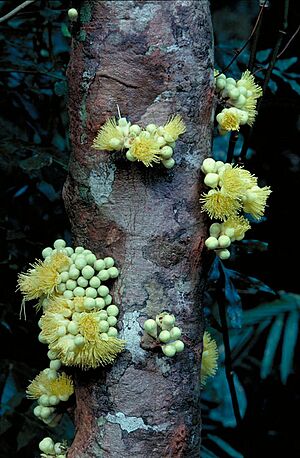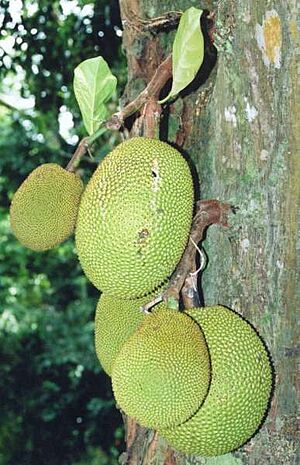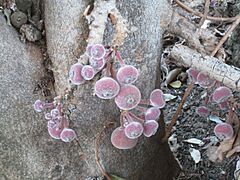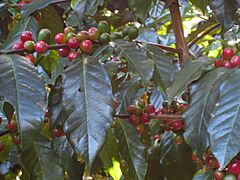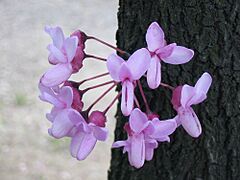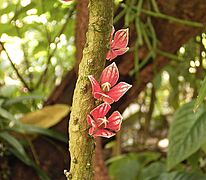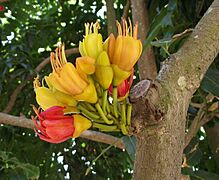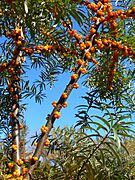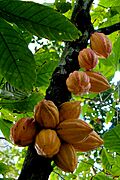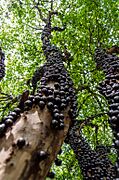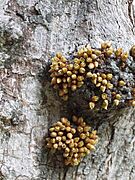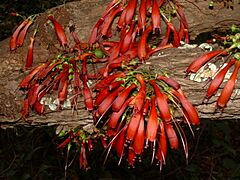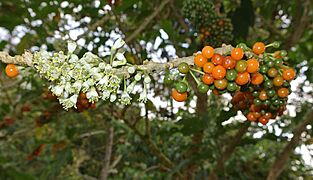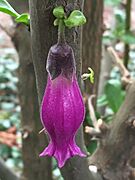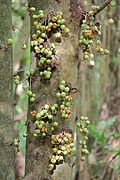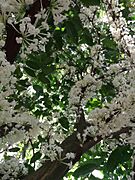Cauliflory facts for kids
Cauliflory is when a plant grows its flowers and then its fruits right on its main stem or its old, woody trunk, instead of on the new branches and shoots that grow each year. Think about most fruit trees you know, like an apple tree. They usually flower and grow apples on the younger branches and twigs. But a cauliflorous plant is different. It might have flowers popping directly out of the bark on its trunk or thick branches.
This is pretty rare in places with seasons like winter (called temperate regions), but it's quite common in warm, wet places like tropical rainforests.
Contents
How does cauliflory happen?
Plants are amazing at finding ways to grow and reproduce. Cauliflory happens because special little buds, which are like tiny beginnings of flowers or branches, develop in unusual places.
Normally, buds that turn into flowers grow at the tips of branches or where leaves join the stem (these are called axillary buds). But in cauliflorous plants, these buds, or sometimes completely new buds that appear out of nowhere (called adventitious buds), wake up and grow on the older, woody parts of the plant.
Imagine a tiny flower bud hiding just under the bark of a tree trunk. In a cauliflorous plant, this hidden bud gets the signal to grow, pushes through the bark, and becomes a flower!
For these buds to grow, they need water and nutrients. The plant has special tubes, like tiny pipes (called vascular tissue), that carry water and food. Even in the old trunk, these tubes connect to the developing flower bud, allowing it to get what it needs to bloom and eventually turn into fruit.
Some plants, like the Eastern Redbud tree (Cercis canadensis), have buds that stay dormant (like sleeping) on the old wood and wake up each year to produce flowers directly on the branches and trunk. Other plants might develop these buds in different ways, sometimes even changing how they do it as they get older! For example, some fig trees might start by flowering on younger parts and later switch to growing flowers right on the trunk.
Scientists have studied how this happens and found that it's not just one single way plants do it. Different plants have developed cauliflory in slightly different ways over a very long time.
Why do plants grow flowers and fruits on their trunks?
This is a great question! Scientists have come up with several ideas about why cauliflory might be helpful for a plant. It's probably not just one reason, but a combination of things depending on the plant and where it lives.
- Helping Animals Reach the Goodies: One popular idea is that growing flowers and fruits on the trunk makes them easier for certain animals to find and eat. In tropical forests, many animals, like bats, monkeys, or other climbing mammals, spend a lot of time on the main trunks and sturdy branches of trees. If the flowers (which might have tasty nectar) or the fruits are right there on the trunk, these animals can easily get to them. When they eat the fruit, they often carry the seeds away and drop them somewhere else, which helps the plant spread to new places.
- Getting Seeds to the Ground: For some plants, having the fruit on the trunk means that when it ripens and falls, it drops straight down to the forest floor. This might be important if the fruit needs to ripen more on the ground or if the seeds need to be dispersed by animals that live on the ground.
- Strong Support for Big Fruits: Some cauliflorous plants grow really big, heavy fruits, like the Jackfruit or the Durian. Imagine trying to hang a giant, heavy fruit on a thin little twig! By growing these fruits directly on the thick, strong trunk or main branches, the plant has much better support. It's like building a heavy shelf right onto a strong wall instead of a flimsy fence.
- Avoiding Competition: Another idea is that growing flowers on the trunk might help the plant avoid competing for resources like sugar and minerals with the new leaves that are growing at the same time on the younger branches. By flowering on the old wood, the flowers and new leaves aren't directly competing for the same limited supplies from the newest growth.
So, cauliflory is likely an amazing adaptation that helps these plants survive and reproduce in their specific environments, often by making friends with animals or providing better support for their fruits.
Flagelliflory
There's an even more unusual type of cauliflory called flagelliflory. In this case, the plant grows very long, thin, whip-like branches that hang down from the trunk. These long branches are where all the flowers grow.
Sometimes, these whip-like branches even grow down to the ground and trail along it, or even slightly under the soil. This makes it look like the flowers are coming right out of the ground next to the tree trunk. It's a really strange and cool sight!
Examples of plants that do this include some species in families like Annonaceae and Moraceae, and also the interesting Cannonball Tree (Couroupita guianensis) and a type of cactus called Weberocereus tunilla.
Examples of plants with cauliflory
Many different kinds of plants around the world show cauliflory. Here are just a few examples:
- Papaya (Carica papaya): Yes, the papaya fruit grows right off the main trunk!
- Cacao (Theobroma cacao): This is the plant that gives us chocolate! The pods containing the cacao beans grow directly on the trunk and main branches.
- Jackfruit (Artocarpus heterophyllus): Known for its enormous fruit, which hangs from the trunk and thick branches.
- Cannonball Tree (Couroupita guianensis): Famous for its large, round fruits that look like cannonballs hanging from the trunk, and its unique flowers.
- Fig Trees (Ficus species): Many types of figs, like the Cluster Fig or Sycamore Fig, have figs growing in clusters right on the trunk or main branches.
- Calabash Tree (Crescentia cujete): Grows large, hard-shelled fruits directly on the trunk and branches, often used to make bowls or containers.
- Kohekohe (Didymocheton spectabilis): A tree from New Zealand that flowers on its trunk and branches.
Related pages
- Ramiflory: This is similar, but the flowers and fruits grow on the larger branches, not necessarily the main trunk.
- Adventitious buds: These are the buds that grow in unusual places on a plant, like directly from the stem or root, rather than from the usual spots where leaves meet the stem. They are often involved in cauliflory.
Image gallery
-
Syzygium moorei fruit
-
Ficus (fig)
-
Coffee Plant (Coffea)
-
Jabuticaba (Plinia cauliflora)
-
Kohekohe (Dysoxylum spectabile)
See also
- Ramiflory
- Spur
- Adventitious buds


